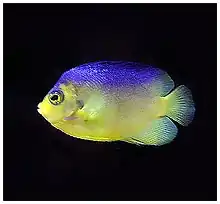Cocos-Keeling angelfish
The Cocos-Keeling angelfish (Centropyge colini), or Colin's angelfish is a small species of ray-finned fish, a marine angelfish belonging to the family Pomacanthidae. It is found in the Indo-West Pacific region.
| Cocos-Keeling angelfish | |
|---|---|
 | |
| Scientific classification | |
| Domain: | Eukaryota |
| Kingdom: | Animalia |
| Phylum: | Chordata |
| Class: | Actinopterygii |
| Order: | Perciformes |
| Family: | Pomacanthidae |
| Genus: | Centropyge |
| Species: | C. colini |
| Binomial name | |
| Centropyge colini Smith-Vaniz & Randall 1974 | |
Description
The Cocos-Keeling angelfish is mainly lemon-yellow in colour with a wide blue stripe from the nape along the back to the middle of the dorsal fin. There is a thin purplish ring around the eye.[2] The dorsal fin contains 14 spines and 16-17 soft rays while the anal fin has 3 spines and 17 soft rays. This species attains a maximum total length of 9 centimetres (3.5 in).[3]
Distribution
The Cocos-Keeling angelfish has been recorded from a scattering of sites in the Indo-West Pacific. These include the Spratly Islands, Palau, Papua New Guinea, Indonesia, Marshall Islands, Cocos Keeling Islands, Fiji and Guam, with an unconfirmed report from the Ogasawara Islands off Japan.[1]
Habitat and biology
The Cocos-Keeling angelfish is found at depths between 20 and 100 metres (66 and 328 ft).[1] It is a shy and secretive species which lives in crevices and caves in deep reef drop offs. It is found in groups which consist of a male and a harem of 2-6 females.[3] The male is replaced by the most dominant female if he disappears. Very little is known about the diet of this species.[2]
Systematics
The Cocos-Keeling angelfish was first formally described in 1974 by William F. Smith-Vaniz and Ernest J. Randall (1924-2020) with the type locality given as Turks Reef in the Cocos-Keeling Islands.[4] Some authorities place this species in the subgenus Centropyge.
Etymology
The specific name honours the biologist Patrick L. Colin who helped collect the type.[5]
References
- Pyle, R.; Myers, R.F. (2010). "Centropyge colini". IUCN Red List of Threatened Species. 2010: e.T165838A6145523. doi:10.2305/IUCN.UK.2010-4.RLTS.T165838A6145523.en. Retrieved 20 November 2021.
- Dianne J. Bray. "Centropyge colini". Fishes of Australia. Museums Victoria. Retrieved 20 January 2021.
- Froese, Rainer; Pauly, Daniel (eds.) (2019). "Centropyge colini" in FishBase. December 2019 version.
- Eschmeyer, William N.; Fricke, Ron & van der Laan, Richard (eds.). "Species in the genus Centropyge". Catalog of Fishes. California Academy of Sciences. Retrieved 17 January 2021.
- Christopher Scharpf & Kenneth J. Lazara (21 July 2020). "Order ACANTHURIFORMES (part 1): Families LOBOTIDAE, POMACANTHIDAE, DREPANEIDAE and CHAETODONTIDAE". The ETYFish Project Fish Name Etymology Database. Christopher Scharpf and Kenneth J. Lazara. Retrieved 17 January 2021.
